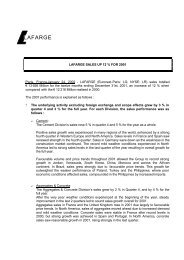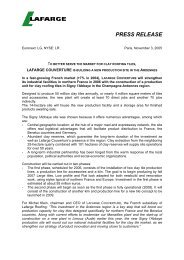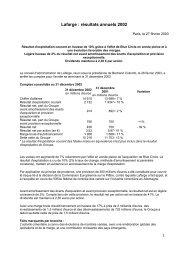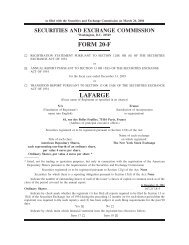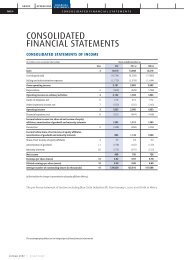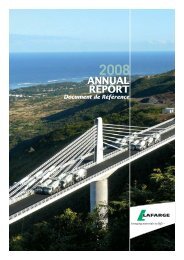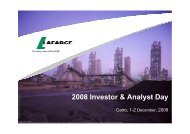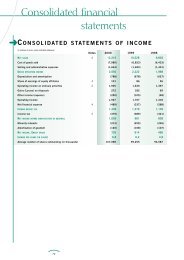2005 Sustainability Report - Lafarge
2005 Sustainability Report - Lafarge
2005 Sustainability Report - Lafarge
Create successful ePaper yourself
Turn your PDF publications into a flip-book with our unique Google optimized e-Paper software.
ENVIRONMENTAL IMPACTS AND COSTS ><br />
Protecting the environment<br />
Working towards<br />
sustainable construction<br />
Sustainable construction aims at<br />
designing buildings that provide an<br />
appropriate response to environmental,<br />
economic and social stakes.<br />
The key drivers in developed countries<br />
are energy savings, personal health and<br />
comfort and water management.<br />
The main additional issues in developing<br />
countries are economic and social<br />
imperatives, such as employment and<br />
access to decent, low-cost housing.<br />
As the world leader in building<br />
materials, <strong>Lafarge</strong> believes that part<br />
of its commitment to society is to look<br />
beyond its sole industrial performance.<br />
The impact of its products needs to be<br />
considered during their entire life cycle<br />
and <strong>Lafarge</strong> is committed to working<br />
closely with the entire construction<br />
BUILDING ENVIRONMENTAL IMPACTS<br />
THROUGHOUT ITS LIFE-CYCLE<br />
100%<br />
80%<br />
60%<br />
40%<br />
20%<br />
0%<br />
Possibility<br />
to influence<br />
impacts<br />
and costs<br />
Impacts and costs<br />
of planning<br />
Impacts<br />
and costs of<br />
construction<br />
PAGE 24 | <strong>2005</strong> SUSTAINABILITY REPORT | LAFARGE<br />
industry to design and promote a more<br />
sustainable construction.<br />
GROUP'S STRATEGIC<br />
FOCUS ON SUSTAINABLE<br />
CONSTRUCTION<br />
In developed countries, the building<br />
sector accounts for around 40% of energy<br />
and natural resources consumption and<br />
40% of waste produced 1 .<br />
80% of the environmental impact<br />
generated by this sector comes from<br />
the use and maintenance of buildings:<br />
heating, air conditioning and hot water.<br />
The remaining 20% is attributable to<br />
materials manufacturing, the building<br />
process, renovation and demolition.<br />
To reduce the environmental impact of<br />
the building sector, the construction<br />
Impacts and costs<br />
during use phase<br />
Cumulated<br />
impacts<br />
and costs<br />
0 PLANNING<br />
CONSTRUCTION<br />
USE AND MAINTENANCE<br />
industry needs to improve performance<br />
mainly during the use and maintenance<br />
phase, but also during all other stages<br />
of the life cycle.<br />
<strong>Lafarge</strong> has therefore defined six<br />
strategic areas:<br />
1 | Production and distribution of our<br />
materials<br />
2 | Facilitate the construction process<br />
3 | Increase materials’ performance<br />
3 | Develop more efficient building<br />
systems<br />
5 | Recycling<br />
6 | Contribute to raising living<br />
standards.<br />
1 | Source: European Commission Directorate General<br />
for Energy and Transport.<br />
Base<br />
100<br />
COMPARISON UTILISATION OF CONSUMPTION<br />
AND DE EMISSIONS MATIÈRES BETWEEN PREMIÈRES<br />
A BRIDGE DE SUBSTITUTION<br />
BUILT OUT OF DUCTAL®<br />
AND (% A COMPOSITE<br />
de l’effecif total)<br />
STEEL/CONCRETE SOLUTION<br />
65<br />
Quantity<br />
of raw<br />
materials<br />
0000 0000 0000<br />
03 04 05<br />
Primary<br />
Energy<br />
Base 100: composite steel/concrete<br />
solution<br />
● Ductal® solution<br />
54<br />
47<br />
CO2<br />
Emissions




